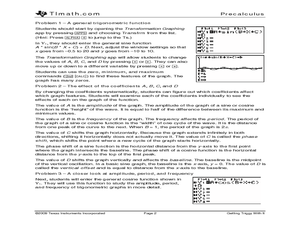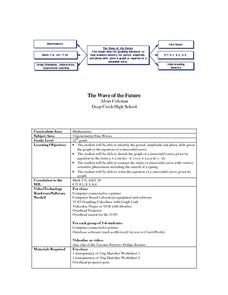Yummy Math
Playing with my calculator on the 4th of July
This fun activity guides learners through an exploration of the effects of replacing f(x) with -f(x), f(x) + c, k f(x), and f(x + c). Using graphing calculators, students experiment with variations of the graph of y = x^2 to design a...
Curated OER
Getting Triggy With It
The concept of sine and cosine is explored in this lesson plan where high schoolers graph sine and cosine graphs using a transformation application on the graphing calculator. Students change the coefficients for the amplitude,...
Curated OER
Investigating Transformations
In this trigonometry worksheet, students investigate the transformations that can occur to the basic trigonometric functions. The thirteen page worksheet contains explanation, examples, and forty-seven...
Curated OER
Modelling Periodic Phenomena
In this Pre-calculus/Trigonometry worksheet, students determine the trigonometric function that best models the given data. The eight page worksheet contains explanation, examples, and twenty-one problems. Answers are not included.
Curated OER
MT-A141 PreCalculus: Worksheet 6.5/6.6
In this precalculus learning exercise, students investigate functions and determine which functions are sinusoids. They estimate the amplitude, phase shift, and period of each function. Students explore the sums of sine and cosine...
Curated OER
Functions
In this function worksheet, students solve 4 different types of equations related to functions. First, they determine a particular solution to the low pass and plot the input and output of the same axes and compare. Then, students...
Curated OER
MT-A141 PreCalculus: Worksheet 6.4
In this precalculus worksheet, students predict the graph of given functions and draw conclusions about each one. Students define a transformation, and determine the amplitude, period, phase shift and vertical shift of given problems. ...
Curated OER
The Wave of the Future
Twelfth graders discuss sine curves and enter equations into their graphing calculator then compare different graphs created on their calculators. They identify the period, amplitude and phase shift given the graph or the equation of a...
Curated OER
Modeling With Circular Functions
Learners explore circular functions. They identify the amplitude, period, phase shift and vertical shift of circular functions. Students analyze phenomena described by sine waves and they find mathematical models for transforming images...
Varsity Tutors
Varsity Tutors: Hotmath: Practice Problems: Graphs of Trigonometric Functions
Hotmath provides 20 practice problems on graphs of trigonometric functions. Each of the practice problems include a step-by-step guide for solving their graphs.
Georgia State University
Georgia State University: Hyper Physics: Interference of Sound
Information about the interference of sound and its causes. Well-illustrated and good explanations of the concepts; part of a large hyper-textbook on various physics concepts.
McGraw Hill
Glencoe: Quiz on the Translations of Sine and Cosine Functions
The online assessment demonstrates knowledge of advanced mathematical concepts in Pre-Calculus. The questions evaluate students on translations of sine and cosine functions. Topics include horizontal and vertical shifts.
McGraw Hill
Glencoe: Online Study Tools: Quiz on Graphs of Trigonometric Functions
Students show comprehension of advanced mathematical concepts in Trigonometry. The online quiz assesses the scholars on the graphs of trigonometric functions.
Analyze Math
Analyze Math: Periodic Functions
The interactive tutorial examines periodic functions. Learners use the applet to manipulate the shape, period, and shift of periodic functions.
Interactive Mathematics
Interactive Mathematics: Phase Shift
The tutorial investigates phase shift by examining the shapes of the sine and cosine functions. The resource consists of definitions, animations, interactive graphs, and examples. Practice problems with solutions are included.
National Council of Teachers of Mathematics
Nctm: Illuminations: Trigonometric Graphing
Explore the amplitude, period, and phase shift by examining the graphs of various trigonometric functions.
















